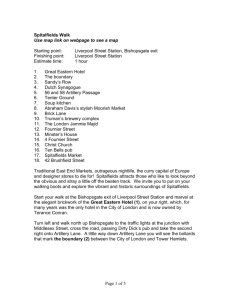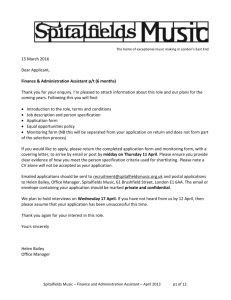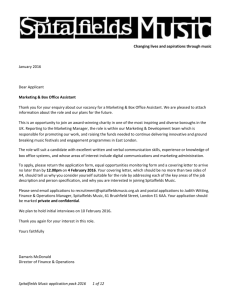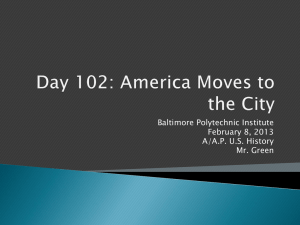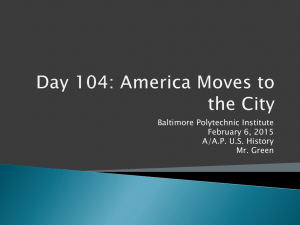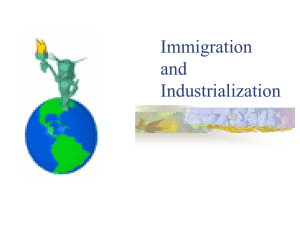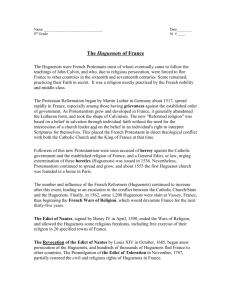spitalfields-brick_lane_1-1
advertisement
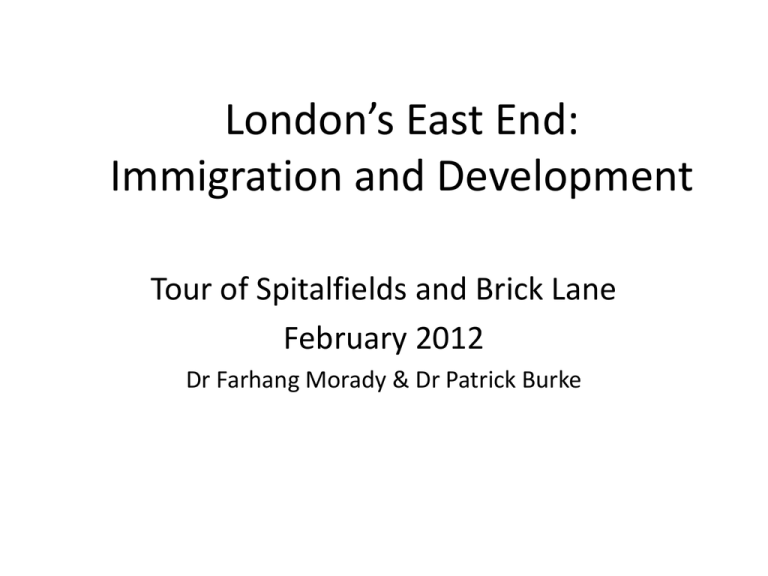
London’s East End: Immigration and Development Tour of Spitalfields and Brick Lane February 2012 Dr Farhang Morady & Dr Patrick Burke London: East End • Covers the districts to the east and outside the medieval (5th-15th centuries) walled City of London; north of the Thames • Grew out of villages clustered around City walls, marshes and Thames • Defensive wall: built by Romans around London; retained until 18th century. • East End includes Whitechapel, Stepney, Shoreditch, Tower Hamlets and Hackney Roman Wall in Tower Hill East End: brief history • Immigrants since 17th century have included: French Protestants (Huguenots); Irish weavers; Ashkenazi Jews; Bangladeshis; Somalis • Immigrants worked in: clothing industry; traded; money lending. • Low wages and poor conditions led to protest • Social reformers and revolutionaries active in East End from mid18th century • An important place for formation of Unions and workers associations • Area developed rapidly in the 19th century • Inhabitants provided services for the Royal Navy • Construction of docks of 1799—1815 • Rural population came looking for employment • East End political radicalism contributed to the formation of the Labour Party. Spitalfields: the beginning • ‘Spitalfields’: name derives from that of a medieval hospital on this site, ‘The priory of St. Mary of the Spittle’. • Relatively rural area until the Great Fire of London (1666) • Late 17th century: slowly becoming a suburb of London Old Spitalfields Market Old Spitalfields Market • 1682 – King Charles II grants John Balch a Royal Charter to hold a market on Thursdays and Saturdays in Spital Square • This encourages more people to move to and settle in the area • Today’s building constructed in 1880s Huguenots: ‘asylum seekers’ and labour migrants • 1670--1710: Huguenots – members of the Protestant Reformed Church of France – arrive in England • Fleeing religious persecution in France: ‘asylum seekers’ • Some 25,000 came to London; many of these to Spitalfields • Also fled to Wales, Ireland, Denmark, Switzerland,etc • • Brought with them silkweaving skills; Silk industry thrived: Spitalfields became known as ‘weaver town’ Christ Church Spitalfields • By 1700: nine Huguenot churches in Spitalfields • Fears about the large numbers of religious ‘non-conformists’, including Huguenots in the area • 12 new Church of England churches built to combat non-conformism • Stipulated that they must have tall spires – to rise above non-conformist chapels! • Christ Church Spitalfields one of these: built by Nicholas Hawksmoor Fournier Street • Houses built mainly in 1720s • Built for Huguenot master silkweavers and mercers (textile merchants) • One of the best preserved collections of early Georgian town-houses in Britain Irish labour migration • From 1730: Irish weavers arrive to work in silk trade • Long working hours for little money forced them to organize illegal trade unions • Frequent riots and other protests against wages and working conditions • 1769: Spitalfields Riots: soldiers try to arrest an entire meeting of weavers; meet resistance; fire on weavers – Two men hanged, one Irish; one Huguenot Jewish immigration: seeking work and asylum • 1881—1914: over 2 million Jews flee economic hardship and brutal persecution in Russia and Eastern Europe. • 120,000 come to England; many to Spitalfields • By 1900 Jews are 95% of the population in the Wentworth Street district of Spitalfields • As they grew wealthier, Jews moved to suburbs like Golders Green and Hendon • Jewish community now almost entirely gone Jewish immigration: seeking work and asylum • Jews – unlike Huguenots – not warmly welcomed • Jewish immigration prompted first UK law designed to limit immigration: the Aliens Act (1905) • In 1930s: British Union of Fascists (led by Oswald Moseley) stoked antisemitic prejudice • 1936: Battle of Cable Street: • Anti-fascists fought the Metropolitan Police • The police wanted to ensure that British Union of Fascists could march through the East End • The protests led to the march being called off Bangladeshi immigration • Immigrants from what is now Bangladesh came to East London as early as late 1600s – Sailors (lascars) on East India Company merchant ships • Significant Bengali migration to England from 1960s • Migration driven by search for work • And for security: upheavals of Partition in 1947 – creation of Pakistan and India – and of 1971 war, which created Bangladesh • Pakistan, and Bangladesh, part of Commonwealth: British Nationality Act 1947 gave Commonwealth citizens right of entry to UK • Later acts restricted entry Bangladeshi community • Early arrivals mainly single working men • Joined later by families • Many Bangladeshi immigrants settled in and around Brick Lane; as well as to the east of the area • Most originate from the Sylhet region in north-east Bangladesh Bangladeshi community • Size of Bangldeshi community led to area being named ‘Banglatown’ • 2001, 68 per cent of the population of the Spitalfields and Banglatown ward was of Bangladeshi origin Bangladeshi community • Migration from ‘New Commonwealth’ countries (eg, India, Bangladesh, Jamaica) helped prompt restrictive legislation: – Eg, Immigration Act 1971 • Bangladeshi, and many other ‘New Commonwealth’ immigrants, in London and elsewhere, have been the target of racial prejudice and hostility • The 1970s saw increasing attacks by the far right National Front One such attack resulted in the murder of Altab Ali in 1978 The Truman Brewery • Formerly the Black Eagle brewery • Brewing on this site began in 1666 • Huguenot immigrants made a significant contribution to the brewery: – Helped create a popular dark beer called porter Anarchist immigrants to the East End • In 1898, Rudolf Rocker, a German nonJewish anarchist who settled in the East End, became editor of the radical Yiddish paper, Arbeter Fraynd (Worker's Friend) • In 1886, the Russian anarchist Peter Kropotkin, living in exile in Britain, helped found the anarchist publisher and bookshop, Freedom Press, just off Whitechapel High St. It still operates today. Reflect on these questions: • What have been the drivers of migration to the Spitalfields area? • What can the history of this area tell us about how immigrants have ‘integrated’? • How should development be understood now? • In what way migration enhance development? • Does East London represent a globalised world: culture, economics and politics? If so, what are the symbols or indicators of this globalised world?

